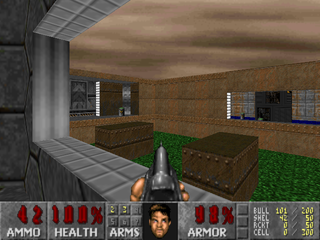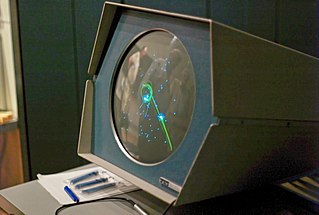
A video game is an electronic game that involves interaction with a user interface or input device, such as a joystick, controller, keyboard, or motion sensing devices, to generate visual feedback on a two- or three-dimensional video display device such as a TV set, monitor, touchscreen, or virtual reality headset. Video games are augmented with audio feedback from speakers or headphones, and optionally with other types of feedback systems including haptic technology.

Hunt the Wumpus is a text-based adventure game developed by Gregory Yob in 1973. In the game, the player moves through a series of connected caves, arranged in a dodecahedron, as they hunt a monster named the Wumpus. The turn-based game has the player trying to avoid fatal bottomless pits and "super bats" that will move them around the cave system; the goal is to fire one of their "crooked arrows" through the caves to kill the Wumpus. Yob created the game in early 1973 due to his annoyance at the multiple hide-and-seek games set in caves in a grid pattern, and it and multiple variations were sold via mail order by Yob and the People's Computer Company. The source code to the game was published in Creative Computing in 1975 and republished in The Best of Creative Computing the following year.

The Compact Disc-Interactive is a digital optical disc data storage format that was mostly developed and marketed by Dutch company Philips. It was created as an extension of CDDA and CD-ROM and specified in the Green Book, co-developed by Philips and Sony, to combine audio, text and graphics. The two companies initially expected to impact the education/training, point of sale, and home entertainment industries, but CD-i eventually became best known for its video games.

The history of video games goes as far back as the early 1950s, when academic computer scientists began designing simple games and simulations as part of their research or just for recreation. At M.I.T. in the 1960s, professors and students played games such as 3D tic-tac-toe and Moon Landing. These games were played on computers such as the IBM 1560, and moves were made by means of punch cards. Video gaming did not reach mainstream popularity until the 1970s and 1980s, when video arcade games and gaming consoles using joysticks, buttons, and other controllers, along with graphics on computer screens and home computer games were introduced to the general public. Since the 1980s, video gaming has become a popular form of entertainment and a part of modern popular culture in most parts of the world. One of the early games was Spacewar!, which was developed by computer scientists. Early arcade video games developed from 1972 to 1978. During the 1970s, the first generation of home consoles emerged, including the popular game Pong and various "clones". The 1970s was also the era of mainframe computer games. The golden age of arcade video games was from 1978 to 1982. Video arcades with large, graphics-decorated coin-operated machines were common at malls and popular, affordable home consoles such as the Atari 2600 and Intellivision enabled people to play games on their home TVs. During the 1980s, gaming computers, early online gaming and handheld LCD games emerged; this era was affected by the video game crash of 1983. From 1976 to 1992, the second generation of video consoles emerged.

A video game console is an electronic or computer device that outputs a video signal or visual image to display a video game that one or more people can play through some type of game controller.
The video game crash of 1983 was a large-scale recession in the video game industry that occurred from 1983 to 1985, primarily in the United States. The crash was attributed to several factors, including market saturation in the number of game consoles and available games as well as waning interest in console games in favor of personal computers. Revenues peaked at around $3.2 billion in 1983, then fell to around $100 million by 1985. The crash abruptly ended what is retrospectively considered the second generation of console video gaming in North America.

Nolan Kay Bushnell is an American businessman and electrical engineer. He established Atari, Inc. and the Chuck E. Cheese's Pizza Time Theatre chain. Bushnell has been inducted into the Video Game Hall of Fame and the Consumer Electronics Association Hall of Fame, received the BAFTA Fellowship and the Nations Restaurant News "Innovator of the Year" award, and was named one of Newsweek's "50 Men Who Changed America." Bushnell has started more than twenty companies and is one of the founding fathers of the video game industry. He is on the board of Anti-Aging Games. In 2012 he founded an educational software company called Brainrush, that is using video game technology in educational software.

Star Control: Famous Battles of the Ur-Quan Conflict, Volume IV or just simply Star Control is a science fiction video game developed by Toys for Bob and published by Accolade in 1990. It was originally released for Amiga and MS-DOS in 1990, followed by ports for the Sega Mega Drive/Genesis, Amstrad CPC, Commodore 64 and ZX Spectrum in 1991. A sequel, Star Control II was released in 1992.
The video game industry is the economic sector involved in the development, marketing, and monetization of video games. It encompasses dozens of job disciplines and its component parts employ thousands of people worldwide. As of 2018, video games generated sales of US$134.9 billion annually worldwide.

Star Trek is a text-based strategy video game based on the Star Trek television series and originally released in 1971. In the game, the player commands the USS Enterprise on a mission to hunt down and destroy an invading fleet of Klingon warships. The player travels through the 64 quadrants of the galaxy to attack enemy ships with phasers and photon torpedoes in turn-based battles and refuel at starbases in order to eliminate all enemies before running out of time.
An online game is a video game that is either partially or primarily played through the Internet or any other computer network available. Online games are ubiquitous on modern gaming platforms, including PCs, consoles and mobile devices, and span many genres, including first-person shooters, strategy games and massively multiplayer online role-playing games (MMORPG). In 2019, revenue in the online games segment reached $16.9 billion, with $4.2 billion generated by China and $3.5 billion in the United States.
Jon Freeman is an influential game designer and co-founder of software developer Automated Simulations, which was later renamed to Epyx and became a major company during the 8-bit era of home computing. He is married to game programmer Anne Westfall, and they work together as Free Fall Associates. Free Fall is best known for Archon: The Light and the Dark, one of the earliest titles from Electronic Arts.
Free Fall Associates was a video game developer of the 1980s and early 1990s founded in 1981 by game designer Jon Freeman, game programmer Anne Westfall, and game designer Paul Reiche III. Westfall and Freeman are married. To start the new company, Freeman and Westfall left Epyx, the company Freeman co-founded in 1978. Free Fall Associates is best known for Archon: The Light and the Dark (1983), which was one of the first games from new publisher Electronic Arts.
An interactive film, also known as movie game, is a video game that presents its gameplay in a cinematic, scripted manner, often through the use of full-motion video of either animated or live-action footage.
Combat flight simulators are simulation video games used to simulate military aircraft and their operations. These are distinct from dedicated flight simulators used for professional pilot and military flight training which consist of realistic physical recreations of the actual aircraft cockpit, often with a full-motion platform.

Spacewar! is a space combat video game developed in 1962 by Steve Russell in collaboration with Martin Graetz, Wayne Wiitanen, Bob Saunders, Steve Piner, and others. It was written for the newly installed DEC PDP-1 minicomputer at the Massachusetts Institute of Technology. After its initial creation, Spacewar! was expanded further by other students and employees of universities in the area, including Dan Edwards and Peter Samson. It was also spread to many of the few dozen installations of the PDP-1 computer, making Spacewar! the first known video game to be played at multiple computer installations.

Computer graphics is the branch of computer science that deals with generating images with the aid of computers. Today, computer graphics is a core technology in digital photography, film, video games, cell phone and computer displays, and many specialized applications. A great deal of specialized hardware and software has been developed, with the displays of most devices being driven by computer graphics hardware. It is a vast and recently developed area of computer science. The phrase was coined in 1960 by computer graphics researchers Verne Hudson and William Fetter of Boeing. It is often abbreviated as CG, or typically in the context of film as computer generated imagery (CGI).
The history of video games spans a period of time between the invention of the first electronic games and today, covering many inventions and developments. Video gaming reached mainstream popularity in the 1970s and 1980s, when arcade video games, gaming consoles and home computer games were introduced to the general public. Since then, video gaming has become a popular form of entertainment and a part of modern culture in most parts of the world. The early history of video games, therefore, covers the period of time between the first interactive electronic game with an electronic display in 1947, the first true video games in the early 1950s, and the rise of early arcade video games in the 1970s. During this time there was a wide range of devices and inventions corresponding with large advances in computing technology, and the actual first video game is dependent on the definition of "video game" used.
Mainframe computers are computers used primarily by businesses and academic institutions for large-scale processes. Before personal computers, first termed microcomputers, became widely available to the general public in the 1970s, the computing industry was composed of mainframe computers and the relatively smaller and cheaper minicomputer variant. During the mid to late 1960s, many early video games were programmed on these computers. Developed prior to the rise of the commercial video game industry in the early 1970s, these early mainframe games were generally written by students or employees at large corporations in a machine or assembly language that could only be understood by the specific machine or computer type they were developed on. While many of these games were lost as older computers were discontinued, some of them were ported to high-level computer languages like BASIC, had expanded versions later released for personal computers, or were recreated for bulletin board systems years later, thus influencing future games and developers.










